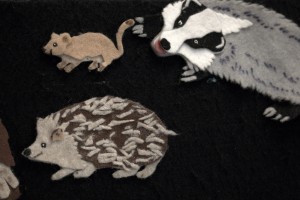I think every early childhood teacher in the country uses Jan Brett’s books in the Winter. I love The Mitten! It is one of those absolute-must have books for the kindergarten classroom. A few years ago I was lucky enough to have a wonderful parent in my classroom who was incredibly talented. She saw that I used felt board stories quite often and offered to make a few for me. She started with The Mitten.

Her work was amazing! Each animal was made of felt pieces, stitching, and a little bit of detail was added with Sharpies. I can’t wait to share this story with my students each year.

I use felt board stories in the classroom all the time. Story retelling is one of those things that I work on all year with my students. First, and foremost, we are working on comprehension. When kids are listening to (or reading) a story, we want them to be focused, rather than letting their minds wander. Comprehension is our main purpose for reading. Without comprehension, why bother spending your time reading? After we read a story, we spend time retelling the story to deepen our comprehension.
In addition, retelling is a form of reading for young children. We often see kids grab a familiar book and retell the story using the pictures in the book and the language that they remember from hearing it. Often times, parents will come to me and say, “My child isn’t actually reading the words. They are just retelling the story from memory.” I always tell parents that this IS reading for young children. They are demonstrating so many wonderful skills that they have learned to use as a reader. This form of retelling helps kids organize and describe a sequence of events, develop oral language, and understand the concept of plot. All of these literacy skills are part of retelling!
Obviously, you can always have your child retell the story after reading a book but there are plenty of other ways to get kids retelling.
*Felt board stories:
Have your child create his or her own felt board pieces that go along with a story. Some felt, Sharpies, and scissors are all you need.
*Story stones:
Draw pictures on river rocks to represent characters, setting, and significant events. You could also print pictures from your computer and Mod Podge these onto rocks.
*Finger retelling:
I use finger retellings all the time in my class. I have the kids hold up five fingers and point to each finger. Each time they point to a finger, they tell something that happened in the story. This is also the strategy I use to help kids plan out stories they want to write.
*Puppets or props:
When my daughter was in kindergarten she came home with stick puppets (copied and colored pictures of the characters, glued onto popsicle sticks) of the 3 Billy Goats Gruff. For the next few weeks, I would find her in different places around the house saying, “Trip trap, trip trap. Who’s that trip trapping over my bridge?” You don’t need a fancy puppet theater or expensive puppets to make this happen at your house!
*Writing their own book:
Blank books are a staple in my classroom and at my house. After reading a story a few times through, have your child create their own version of the book with their own words and illustrations. You can even point out that Jan Brett was not the original author of The Mitten. It’s actually an old Ukranian folktale that she rewrote and created beautiful illustrations for.
Winter is winding down here in the Pacific Northwest, but it’s not too late to break out a few books from a favorite children’s author and illustrator who loves to write books in snowy settings. I highly recommend starting with The Mitten. You will probably enjoy it as much as your kids!
Happy reading and retelling!